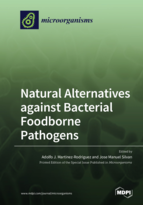Natural Alternatives against Bacterial Foodborne Pathogens
A special issue of Microorganisms (ISSN 2076-2607). This special issue belongs to the section "Food Microbiology".
Deadline for manuscript submissions: closed (30 November 2019) | Viewed by 70073
Special Issue Editors
Interests: foodborne pathogens; food safety; antibiotic resistance; natural antimicrobial compounds; biofilms; Campylobacter spp.; Helicobacter pylori
Special Issues, Collections and Topics in MDPI journals
Interests: foodborne pathogens; antimicrobial agents; food by-products; food bioactive compounds; food control
Special Issues, Collections and Topics in MDPI journals
Special Issue Information
Dear Colleagues,
In recent years, increased resistance to antibiotics and disinfectants from foodborne bacterial pathogens has become a relevant consumer health issue and a growing concern for food safety authorities. In this situation, there is great interest in developing new strategies that can be used as useful alternatives to antibiotics and disinfectants. Natural antimicrobials are among the most promising candidates, as these substances have good acceptability, low toxicity levels, and high sustainability. Many of these natural compounds have been shown to have different bioactivities (e.g., antimicrobials, anti-inflammatories, inhibitors of bacterial adherence and biofilm formation, etc.) against the main foodborne pathogens, including Campylobacter, Salmonella, Listeria, E. coli, Clostridium, and others. This Special Issue of Microorganisms is focused on presenting the state-of-the-art in these new developments. We invite you to submit your most recent contributions to this field to this Special Issue, including (but not restricted to) the following natural alternatives:
- Antimicrobial and anti-inflammatory peptides;
- Bacteriophage therapy;
- Fatty acids and essential oils;
- Food ingredients and food by-products;
- Inhibitors of bacterial adherence, bacterial biofilms, and quorum sensing;
- Microbial-derived products;
- Nanomaterials, nanoparticles, nanotechnology;
- Phytochemicals and plant extracts;
- Probiotics and next-generation probiotics;
- Vaccination and subunit vaccines.
Dr. Adolfo J. Martinez-Rodriguez
Dr. Jose Manuel Silvan
Guest Editors
Manuscript Submission Information
Manuscripts should be submitted online at www.mdpi.com by registering and logging in to this website. Once you are registered, click here to go to the submission form. Manuscripts can be submitted until the deadline. All submissions that pass pre-check are peer-reviewed. Accepted papers will be published continuously in the journal (as soon as accepted) and will be listed together on the special issue website. Research articles, review articles as well as short communications are invited. For planned papers, a title and short abstract (about 100 words) can be sent to the Editorial Office for announcement on this website.
Submitted manuscripts should not have been published previously, nor be under consideration for publication elsewhere (except conference proceedings papers). All manuscripts are thoroughly refereed through a single-blind peer-review process. A guide for authors and other relevant information for submission of manuscripts is available on the Instructions for Authors page. Microorganisms is an international peer-reviewed open access monthly journal published by MDPI.
Please visit the Instructions for Authors page before submitting a manuscript. The Article Processing Charge (APC) for publication in this open access journal is 2700 CHF (Swiss Francs). Submitted papers should be well formatted and use good English. Authors may use MDPI's English editing service prior to publication or during author revisions.
Keywords
- foodborne pathogens
- antibiotic resistance
- multidrug-resistant strains
- natural compounds
- antibacterial activity
- anti-inflammatory activity
- antibiotic alternatives
- bacterial biofilms
- bacteriophage therapy
- essential oils
- food by-products
- nanoparticles
- phenolic compounds
- plant extracts
- probiotics
- sustainability
- vaccination
- anti-adherence properties
- bacteriocins








